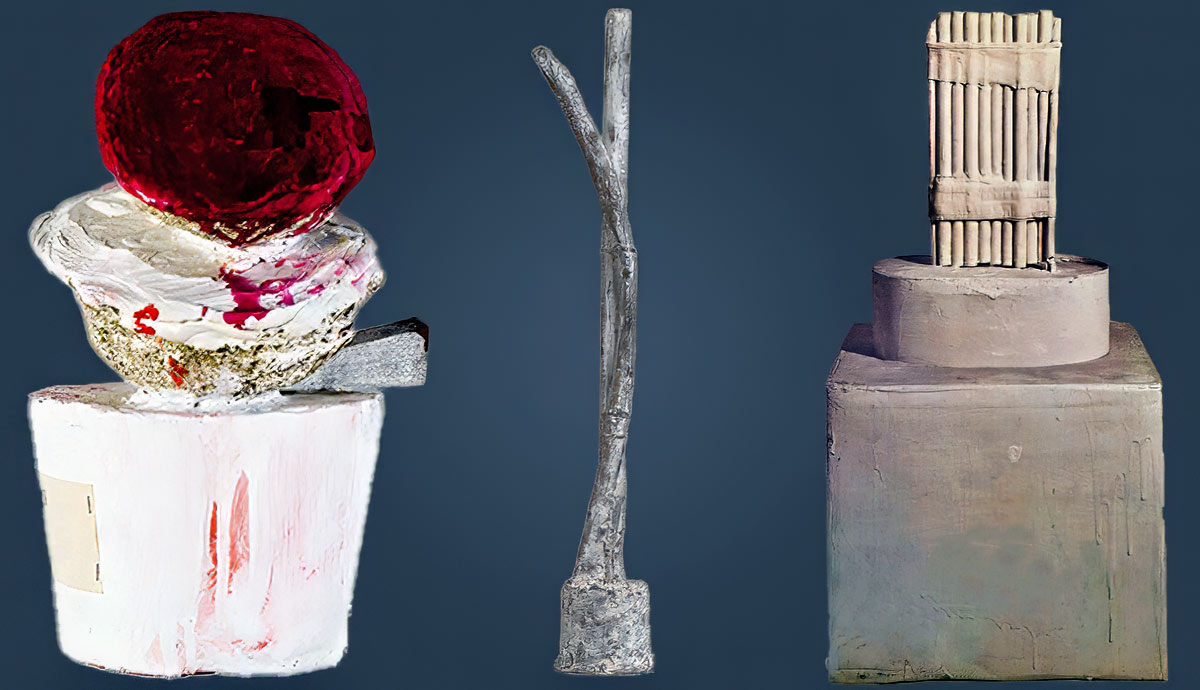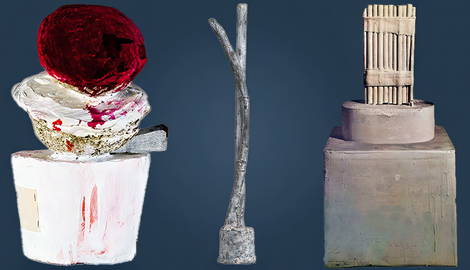
American artist Cy Twombly is heralded as a major presence in 20th-century art. He is best known for his idiosyncratic developments beyond abstract expressionism, incorporating writing and allusions to the classical world into his gestural surfaces. His paintings have dominated professional discussions of his work. But sculpture was a recurrent and entangled presence in Twombly’s practice as well. The same can also be said for his photography.
Cy Twombly, Sculptor?

Quieter, enigmatic, and moderately sized, Twombly’s sculptures can be understood in dialogue with his paintings, as a medium in which he reflected on and explored related themes, motifs, images, gestures, and effects in a three-dimensional space. There’s often a familiarity between the surfaces of his paintings and sculptures. There’s Twombly’s prevalent use of white paint, as well as sparse expressive mark-making and written inscription. But the sculptures also have their own character.
A Brief Timeline of Twombly and Sculpture

Twombly was making sculptures as early as the 1940s and continued to do so during his artistic development through the 1950s. Sculptures were part of his output when he returned to New York after his famous and formative travels to Europe and North Africa with Robert Rauschenberg in 1952. In 1954, he made plaster sculptures in the sand on Staten Island, although these have since been lost. In 1959, however, he stopped working with the medium for nearly two decades. It wasn’t until 1976 that he returned to it, but after this hiatus, he wouldn’t leave sculpture behind again.
In 1979, the Galleria Lucio Amelio in Naples hosted the first exhibition focused on Twombly’s sculptures. In the following decades, sculpture became a recurrent and expanding dimension of Twombly’s practice alongside painting, drawing, and photography. In 1982, an exhibition of new sculptures was part of the festival Documenta 7 at Kassel, but Twombly’s first solo show of sculptures in the USA didn’t take place until 1997. The exhibition was finally organized at the Gagosian Gallery in New York. His Catalogue Raisonné of Sculpture which was written by Nicola Del Roscio was also published on this occasion.

Later in life, in various studios on either side of the Atlantic, Twombly devoted an increasing proportion of his time to making sculptures, and his sculptures have since been more frequently exhibited—often in the context of his other work, although also in their own right as in Cy Twombly: Sculpture at MoMA in 2011 and more recently at Gagosian, London in 2019.

Photographer Sally Mann’s series Remembered Light is a study of Cy Twombly’s studio in Lexington, USA. Twombly was actually born in Lexington and spent half of his year in later life there, splitting his time between USA and Italy. Among other things, this photographic series serves as an informative and emotive documentation of the sculptures, both complete and still in progress. However, there is still a distinct deficiency in works written about Twombly as a sculptor.
Twombly’s Sculptural Method

Over the years, Twombly’s basic methodology for making sculpture remained notably consistent. The early sculpture Untitled (Funerary Box for a Lime Green Python) was made in 1954, following Twombly’s first trip to the Mediterranean. Even so, it embodies much of what would refrain in Twombly’s sculptural practice over the years: the foundational assemblage process unified by a coating of white paint, the moderate scale, the box shape, and the allusions to funerary culture and images.

Twombly’s sculptures tend toward a scale that corresponds to the human body, lending intimacy to the viewing experience. Generally, they are composed of objects (historical and contemporary, from the kitsch to the solemn) and construction materials like wood, iron, and plaster that are often coated in white paint, occasionally with the addition of color or written inscription.
White paint is my marble—this statement by Twombly is often quoted in conversations about his sculpture, and indeed it is a useful one for situating these works within his oeuvre, and their relationship with art history and antiquity. Twombly was not straightforwardly an American artist, but an artist deeply involved with the old world of Mediterranean Europe, where he spent much of his life following his first visit in 1952. He also largely relocated to Italy in 1957.

From the 1970s Twombly began to cast quite a number of his sculptures, creating bronze copies of his idiosyncratic assemblages. Both of his techniques of white-washing a collage-like sculptural structure and that of casting it in bronze, have the effect of creating a new unified and unique whole whose origins are at least partly obscured.
Flowers, Tombs, Columns, and Boats

A number of Twombly’s sculptures incorporate references to the natural world. For example, the piece Untitled, Gaeta includes dried flowers. In Thicket—part of a series that refers to Mesopotamia and inspired by Sumerian sculpture—plastic leaves are embedded in amorphous plaster. In Thermopylae cloth flowers are coated in plaster and erected from an organic-shaped mound made from wicker and cloth.
Each in its own way recalls the presence of flowers at gravesides and memorials, and the eruption of vegetation around ruined architecture. Effectively, they put the cycles of life and decay of both the natural world and architectural culture in dialogue. In Scent of a Rose no organic or even faux-organic objects are used, but rather the dense and dripping application of dark red-pink paint to the structure intensifies the implication of the floral. This piece closely echoes Twombly’s 2008 series of Rose paintings, and could perhaps be considered a precursor.

Thermopylae (held in the Menil Collection, Houston) exemplifies Twombly’s frequent process of making a white original—an assemblage of materials coated in white paint—and then creating another version of the same sculpture by casting this original in bronze. It’s also an example of how Twombly’s frequent inclusion of writing in his painting transposes over to his sculpture. The original features a quote from the Greek poet Contantine Cavafy. That many of Twombly’s sculptures are suggestive of tombs, grave markers, memorial plaques, and other monuments entwined with the visual culture of death and mortality is often noted by commentators. The title Thermopylae alludes to a historical mountain pass that was the site of the death of a Spartan king and his army. Its visual relationship with Etruscan tombs has also been noted.

Next to plinths and box shapes, narrow vertical shapes are also a prevalent recurrence in Twombly’s sculpture, recalling architectural columns but also carrying anthropomorphic connotations of the human form. This has led some commentators to compare Twombly’s work with the thin figures of the Swiss sculptor Alberto Giacometti. The bronze Untitled (St Sebastian) exemplifies this compromised verticality, an architectural erectness modified and humanized by imperfect surfaces, curves, and fragmentary ruins. This quality can be seen echoed through the sculptures in Twombly’s Lexington studio, as photographed by Mann.

Echoes of vessels and vehicles symbolically charged and closely linked with antiquity are also recurrent in Twombly’s body of sculptural work. Abstracted chariot shapes are made strange by their pale stillness in Chariot of Triumph and Untitled (1991), for example. The image of the boat became a keystone of Twombly’s practice in the later decades of his life. It carries connotations of coastal environments and key narratives from the Classical world, as well as the idea of passing over and, again, mortality. Winter Passage, Luxor (1985) is an example of this. Drawing on ancient Egyptian imagery following a visit to Luxor, its simple combination of shapes recalls the image of a burial vessel on water and the idea of crossing the river Nile to the afterworld.
The Ambiguity Cy Twombly’s Sculptures

The whites of Twombly’s sculptures are distinctively not pure. They range through various off-whites, with rough and unevenly applied surfaces, often sullied by textures, marks, mixed-media inscriptions, or color. His pale surfaces are charged with implications of history and erosion, defamiliarized through the often light-weight rubble-like quality of his materials. As such they suggest not the brilliant white of modernist architecture or the white cube gallery but pieces of the past that have been left to deteriorate, bleached in the sun or scrubbed by the elements, but that retain something essential or symbolic. They are, as Twombly himself suggests, reminiscent of the marble of antique Mediterranean ruins and statuary, but also of the white-washed antebellum facades of the American South.
In any case, this spectral whiteness speaks specifically to the fragility of structure and culture, to the details and distinctions that are lost in time. But his voicing of a world of classical marble and antique artifacts uses a lexicon of contemporary and industrial materials. The loss implicated in the pale surfaces and uncertain architectural shapes isn’t the result of a long period of deterioration, but often a substance and idea with which he has veiled them.
His sculptures present themselves as fragments, ruins, but of what original whole? There isn’t one. They are uncanny objects, as playful as they are grave.

Poet Frank O’Hara described Twombly’s sculpture as witty and funereal, a phrase that captures its wavering ambiguity. Twombly’s often ‘untitled pieces tend to occupy an uncertain and uncanny position between antique and contemporary, figurative and abstract, ethereal and crude, fragile and industrial, elegiac and humorous, fragmentary and whole. Although riddled with recurrences and tendencies, in his sculpture, Twombly never settles into a practice we can confidently define the edges of. While whiteness is such a consistent feature, color also comes into play in some of Twombly’s sculptures, especially in his later work. His 2000 piece Turkish Delight, for example, is gaudy, delightful, and startling in the midst of his other work, coated almost entirely in bright green and red paint.










